Do you have a question about the Fleetwood Flair 2000 and is the answer not in the manual?
Details owner's responsibilities for normal maintenance and warranty claims.
Lists exclusions and limitations of the warranty coverage.
Warning against storing flammable liquids like LP gas containers inside the vehicle.
Lists helpful phone numbers for appliance service and warranty information.
How to report vehicle defects that could cause crashes or injury.
Discusses vehicle damage, injury risks, and defensive driving practices.
Provides information on proper and safe loading of the motor home.
Information on towing weight limits, hitches, and brake controls.
Emphasizes the operator's responsibility for safe loading.
Defines the maximum weight of occupants and cargo.
Provides guidelines and warnings for towing vehicles or trailers.
Advice on hitch types, tongue weight limits, and consulting manuals.
Warns that exceeding GVWR, GCWR, etc., can cause crashes and void warranties.
Explains how to distribute weight safely within the motor home.
Instructions for weighing the motor home without a towed vehicle.
Instructions for weighing the motor home and towed vehicle together.
Lists negative effects of exceeding weight limits, including safety and warranty.
Provides essential tips for safely loading cargo and equipment.
Warning against storing flammable materials like LP gas inside the motor home.
Guidelines for proper tire inflation and initial pressure adjustments.
Step-by-step instructions for handling a flat tire situation safely.
Advises against changing tires oneself to avoid injury or damage.
Information on proper use and maintenance of seats and seat belts.
Emphasizes wearing safety belts correctly for maximum protection.
Instructs on correct shoulder belt placement to avoid injury.
Provides guidance on using safety restraints for children.
Advice on proper positioning of safety belts for children.
Recommendations for using child safety seats and proper installation.
Information on operating the motor home safely while driving.
Explains how to use the engine for slowing the vehicle on grades.
Warns against parking or idling over flammable materials due to exhaust heat.
Warns about slowly releasing fuel cap pressure to prevent spray.
Essential precautions to prevent carbon monoxide poisoning.
Warns against operating engines while sleeping due to CO poisoning risk.
Advises ensuring safe dispersion of exhaust gases and monitoring outside conditions.
Explains the function of the CO detector and testing procedures.
Guidelines and precautions for emergency towing of the motor home.
Warns against towing from the rear due to potential suspension and tire failure.
Warns against using the leveling system as a jack due to potential instability.
Explains the purpose and operation of the emergency exit window.
Warns against storing flammable or hazardous chemicals inside due to toxic fumes.
Explains condensation causes and methods for control.
Key actions are reducing moisture release and increasing ventilation.
Lists actions to minimize moisture generation inside the RV.
Steps to increase air circulation to reduce condensation.
Warns not to cover emergency exit windows, keeping them accessible.
Essential precautions to prevent and manage fires in the motor home.
Warns against storing LP gas or flammable liquids inside the motor home.
Warns about urethane foam's flammability and hazards of burning foam.
Safety steps before refueling, turning off appliances, and handling pilot lights.
Actions to take during a fire and considerations for major fires.
Explains the function of the smoke detector and testing procedures.
Guide to diagnosing and resolving issues in the fresh water system.
Discusses causes of leaks, checking fittings, and preventing freezing damage.
Step-by-step procedure for sanitizing the water tank and piping with bleach.
Instructions and warnings for draining the holding tanks.
Stresses draining tanks into approved dump stations and regular rinsing.
Safety guidelines for charging batteries, including warnings.
Warns about hydrogen gas, electrolyte contact, and electrical sparks during charging.
Warns against operating the 120-volt system without a proper ground due to electrocution risk.
Explains GFCI purpose, testing, and troubleshooting.
Warns against using fuses/breakers with higher amperage ratings than specified.
Describes the gasoline or LP gas generator and its control panel.
General safety precautions for generator operation.
Warns against placing flammable materials in the generator compartment.
Covers warnings for sleeping operation, location, modification, ventilation, and exhaust gases.
Essential precautions to prevent hazards associated with LP gas.
Covers hazards, detection methods, inspection, and drilling precautions.
Advises storing containers outside, with valves closed and plugged.
Warns that overfilling can cause fire and explosion due to uncontrolled gas flow.
Specifies correct installation of LP gas regulators with downward-facing vents.
Warns against adjusting the regulator, as it is preset by the manufacturer.
Instructions and warnings for filling LP gas tanks.
Warns against overfilling LP gas containers and the associated fire hazard.
Instructs to turn off LP gas valves and pilot lights before refueling.
Describes how to check for gas leaks, including detecting odors and using soap solution.
Step-by-step guide for performing a leak check on the LP gas system.
Warns against using open flames or household detergents for leak checks.
Warns that portable fuel-burning appliances are unsafe for heating due to asphyxiation risk.
Covers engine, generator, LP gas, appliances, and water systems winterization.
Details owner's responsibilities for normal maintenance and warranty claims.
Lists exclusions and limitations of the warranty coverage.
Warning against storing flammable liquids like LP gas containers inside the vehicle.
Lists helpful phone numbers for appliance service and warranty information.
How to report vehicle defects that could cause crashes or injury.
Discusses vehicle damage, injury risks, and defensive driving practices.
Provides information on proper and safe loading of the motor home.
Information on towing weight limits, hitches, and brake controls.
Emphasizes the operator's responsibility for safe loading.
Defines the maximum weight of occupants and cargo.
Provides guidelines and warnings for towing vehicles or trailers.
Advice on hitch types, tongue weight limits, and consulting manuals.
Warns that exceeding GVWR, GCWR, etc., can cause crashes and void warranties.
Explains how to distribute weight safely within the motor home.
Instructions for weighing the motor home without a towed vehicle.
Instructions for weighing the motor home and towed vehicle together.
Lists negative effects of exceeding weight limits, including safety and warranty.
Provides essential tips for safely loading cargo and equipment.
Warning against storing flammable materials like LP gas inside the motor home.
Guidelines for proper tire inflation and initial pressure adjustments.
Step-by-step instructions for handling a flat tire situation safely.
Advises against changing tires oneself to avoid injury or damage.
Information on proper use and maintenance of seats and seat belts.
Emphasizes wearing safety belts correctly for maximum protection.
Instructs on correct shoulder belt placement to avoid injury.
Provides guidance on using safety restraints for children.
Advice on proper positioning of safety belts for children.
Recommendations for using child safety seats and proper installation.
Information on operating the motor home safely while driving.
Explains how to use the engine for slowing the vehicle on grades.
Warns against parking or idling over flammable materials due to exhaust heat.
Warns about slowly releasing fuel cap pressure to prevent spray.
Essential precautions to prevent carbon monoxide poisoning.
Warns against operating engines while sleeping due to CO poisoning risk.
Advises ensuring safe dispersion of exhaust gases and monitoring outside conditions.
Explains the function of the CO detector and testing procedures.
Guidelines and precautions for emergency towing of the motor home.
Warns against towing from the rear due to potential suspension and tire failure.
Warns against using the leveling system as a jack due to potential instability.
Explains the purpose and operation of the emergency exit window.
Warns against storing flammable or hazardous chemicals inside due to toxic fumes.
Explains condensation causes and methods for control.
Key actions are reducing moisture release and increasing ventilation.
Lists actions to minimize moisture generation inside the RV.
Steps to increase air circulation to reduce condensation.
Warns not to cover emergency exit windows, keeping them accessible.
Essential precautions to prevent and manage fires in the motor home.
Warns against storing LP gas or flammable liquids inside the motor home.
Warns about urethane foam's flammability and hazards of burning foam.
Safety steps before refueling, turning off appliances, and handling pilot lights.
Actions to take during a fire and considerations for major fires.
Explains the function of the smoke detector and testing procedures.
Guide to diagnosing and resolving issues in the fresh water system.
Discusses causes of leaks, checking fittings, and preventing freezing damage.
Step-by-step procedure for sanitizing the water tank and piping with bleach.
Instructions and warnings for draining the holding tanks.
Stresses draining tanks into approved dump stations and regular rinsing.
Safety guidelines for charging batteries, including warnings.
Warns about hydrogen gas, electrolyte contact, and electrical sparks during charging.
Warns against operating the 120-volt system without a proper ground due to electrocution risk.
Explains GFCI purpose, testing, and troubleshooting.
Warns against using fuses/breakers with higher amperage ratings than specified.
Describes the gasoline or LP gas generator and its control panel.
General safety precautions for generator operation.
Warns against placing flammable materials in the generator compartment.
Covers warnings for sleeping operation, location, modification, ventilation, and exhaust gases.
Essential precautions to prevent hazards associated with LP gas.
Covers hazards, detection methods, inspection, and drilling precautions.
Advises storing containers outside, with valves closed and plugged.
Warns that overfilling can cause fire and explosion due to uncontrolled gas flow.
Specifies correct installation of LP gas regulators with downward-facing vents.
Warns against adjusting the regulator, as it is preset by the manufacturer.
Instructions and warnings for filling LP gas tanks.
Warns against overfilling LP gas containers and the associated fire hazard.
Instructs to turn off LP gas valves and pilot lights before refueling.
Describes how to check for gas leaks, including detecting odors and using soap solution.
Step-by-step guide for performing a leak check on the LP gas system.
Warns against using open flames or household detergents for leak checks.
Warns that portable fuel-burning appliances are unsafe for heating due to asphyxiation risk.
Covers engine, generator, LP gas, appliances, and water systems winterization.
| Brand | Fleetwood |
|---|---|
| Model | Flair 2000 |
| Category | Motorhomes |
| Language | English |
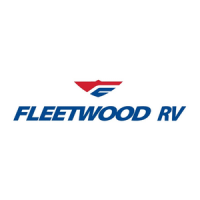
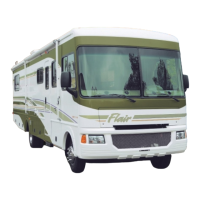



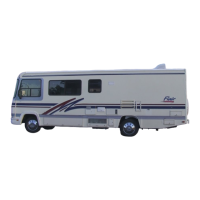
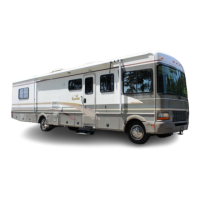




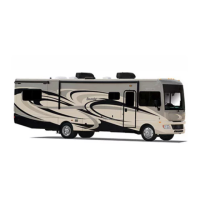
